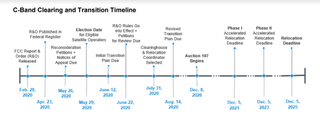SES Tells FCC It Will Be Buying American
International satellite services company SES has filed its accelerated C-Band transition plan with the FCC and it signaled some its moving and incentive expenses being offered by the FCC will be going back into the U.S. economy.
Related: FCC Opens C-Band Relocation Plan Docket
The plans of satellite operators for how they will move from using all 500 MHz of the band to 200 MHz by 2023 were due June 19.

SES and other operators pledged to move by 2023--two years earlier than the FCC's 2025 deadline--in exchange for incentive payments totaling billions of dollars. But they have to tell the FCC exactly how they are going to get that done.
SES said it will hire U.S. companies to install or retune ground equipment, build the satellites needed for the transition, and launch those satellites.
Related: FCC Won't Delay C-Band Auction
It says it will create a database to ensure an "efficient rollout and accurate accounting, get input from industry groups to share best practices and reach out to earth station operators--notably broadcasters and cable operators who use the band for network programming and remote-to-studio transmissions like live sports and concerts.
Multichannel Newsletter
The smarter way to stay on top of the multichannel video marketplace. Sign up below.
It said it will make sure that those earth stations have been pointed and tuned correctly, have upgraded compression technology and filters to protect against interference from the 5G broadband services that will be sharing the band once the FCC auctions the other 280 MHz (there is also a 20 MHz guard band) starting in December. It will also establish an earth station "help desk" and install antennas and ground control equipment.
Related: FCC Provides Guidance for C-Band Payment Clearinghouse
The result, it said, is that 1) wireless broadband operators getting access to the spectrum will roll out 5G in 46 U.S. markets as early as December 2021 and to all Americans by December 2023 and 2) there will be a "seamless continuation" of TV and radio program delivery via C-band to about 120 million homes.
Cable operators have been waiting to see the plans by SES and other C-Band satellite companies so they can figure out how much the transition is going to cost them, then ask the FCC for the money to cover it.
A politically divided FCC voted Feb. 28 on a final order creating the auction of C-Band midband satellite spectrum for terrestrial wireless, as well as approving rules for the auction.
The Democratic commissioners were opposed to the potential incentive payments to satellite operators for moving off their spectrum early.
Contributing editor John Eggerton has been an editor and/or writer on media regulation, legislation and policy for over four decades, including covering the FCC, FTC, Congress, the major media trade associations, and the federal courts. In addition to Multichannel News and Broadcasting + Cable, his work has appeared in Radio World, TV Technology, TV Fax, This Week in Consumer Electronics, Variety and the Encyclopedia Britannica.










